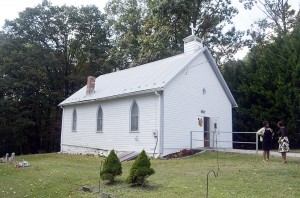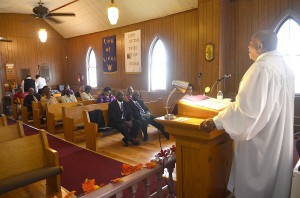On a hillside below Catoctin Mountain, worshippers walk through morning sunlight between a wood frame building and a small white clapboard church with a chimney, a steeple and a cross on the roof.
They pass a cemetery no bigger than a garden patch where marked headstones date to 1894 and unmarked ones likely date back farther, to a time when the forefathers of today’s congregation, men and women who were born slaves and died free, founded the church that still stands here in a rural area south of Frederick once known as Mountville.
“My grandfather used to live up the street there,” says Monk Jones, gesturing up the hillside. His great-grandfather was among the church’s founders. His uncles are buried in the cemetery. “I remember when I was 8, 9 years old we had a path that came right to church.”
The path is gone. His family, like most of the other original families, has moved away. But the tiny church remains. Sunlight streams through its arched Gothic windows, shining in on polished wooden floors and rows of pews sparsely filled with churchgoers.
“This is a historic day!” exults Pastor Kenneth Mitchell, as he takes his place at the front of the Sunnyside New Life Community Church. “The 135th anniversary of this church! Can you believe it?”
It wasn’t always clear the church would see this anniversary. Congregants have battled in the courts, the legislature and the house of God.
“We had to go through a storm,” choir director Jeff Thompson tells the crowd. “But we came out of the storm.”
First a school, then a church
The history of Sunnyside began two decades before its members had a place to worship. After the 1863 Emancipation Proclamation, freed slaves turned sharecroppers sought land to call home. Among them were Jacob and Ellen McKinney. In 1878, the Frederick County couple bought several acres in Mountville, an African-American community blossoming south of Frederick.
Its residents wanted two things: a cemetery for their dead and a school for their children. The nearest black school was eight miles away in downtown Frederick.
“Can you imagine walking from there to Frederick city? And back?” Mitchell said.
In 1887, John T. and Ellen Weedon, George and Ellen Jones, George and Caroline Nicholas and Joseph Shorter mortgaged their homes, combined their assets and bought nearly two acres on the southeast slope of a hill. They built a schoolhouse that served for generations as the Mountville Colored School.
“My father actually went to school in that one-room schoolhouse,” said Roxanne Weedon-Thrasher, the church’s longtime historian.
One of just two remaining 19th century rural black schoolhouses in Frederick County, the old school “represents an important aspect of African-American history in Frederick County,” according to the Maryland Historic Trust, which recommended the building as eligible for listing on the National Register of Historic Places in 2002.
At first, the school doubled as a church. In 1899, calling themselves the Sunnyside Methodist Episcopal Church, congregants built a new house of worship facing it.
“The sun is brighter on that side of the mountain,” Weedon-Thrasher said. “My dad said that they always looked to the mountains, looked to the hills. That side of the mountain was shining on them when they went for refuge away from the slaveholders.”
Most of the 25 members of the church today are descendants of the original founders. Through intermarriage, many are related to one another. Congregations often refer to themselves as church families; at Sunnyside, members mean it literally.
tracing ancestry
“Here we are today standing on the shoulders of those first freed slaves of Frederick County and the first parishioners of Sunnyside,” Mitchell tells the crowd.
He is tall, stocky and bald, with high cheekbones and bright eyes that blaze across the sanctuary. Wearing a white robe emblazoned with gold Latin crosses and a white tippet around his neck, he waves his arms as he preaches, jumps and sings with the choir — and invokes the congregation to rise, clap and shout with him.
“God has been calling men and women to Sunnyside for 135 years and he’s continuing to do the same thing today!”
“Amen!” the congregation shouts.
Ceiling fans blur above the wood-paneled walls. Two flat-screen monitors in the front of the hall, on either side of a white cross, display the lyrics of the upcoming hymn.
When Mitchell asks descendants of the founders to stand, several trace their ancestry to more than one.
A rare newcomer
“When I was a kid going to church, there were cousins across every pew,” Weedon-Thrasher said. “And it’s still that way. My mother always told me, ‘You got to marry a man in church.’ I said, ‘Not in this church!’”
Inside Sunnyside, the days of slavery seem not so distant. The former slaves who raised these walls are only a few generations removed from the members with the same last names who now pray within them.
Founder Jacob McKinney’s son taught Weedon-Thrasher’s Sunday school class.
“We always thought he was an old stick-in-the-mud,” she said with a laugh. “Thinking back on it, he was always pleasant, and always patient.”
Mitchell is a rare newcomer. He came to the church in 2005 when it was part of the United Methodist Church. Born in Georgia, his grandfather was a circuit preacher, one of the legion of itinerant ministers who roamed the rural South.
“They would go from community to community just preaching the word of God,” he said. “Back in those days, their payment was perhaps hospitality or something. That’s what I was accustomed to as a preacher. If you were doing God’s work, God will take care of you.”
Mitchell receives no salary. None of the collection plate goes into his pocket. Sundays he’s in front of the church. Other days, he runs a cleaning service.
“Most of these churches are so small they can’t afford to pay a pastor,” he said. “They don’t have that type of income coming in.”
Mitchell came to Frederick when he was stationed at Fort Detrick. He stayed, married and became certified as a lay speaker at the Asbury United Methodist Church. At that time, Sunnyside was part of a charge, four churches served by the same minister. Congregations rotated churches.
When Sunnyside called out for its own minister in 2006, the Baltimore-Washington conference of the denomination asked Mitchell to take it on.
“They needed to be nurtured spiritually,” he said. “They needed a shepherd.”
They also needed a lawyer.
a question of ownership
As far as the Sunnyside congregation was concerned, the land its founders bought and the buildings they raised by hand belonged to the current members, bequeathed to them by the founders.
The United Methodist Church disagreed. Sunnyside merged with the UMC in 1968, like many other historically-black Methodist Episcopal churches. According to UMC policy, all church property is to be held in trust for the entire denomination. A 1976 law passed in the Maryland General Assembly affirmed that.
Methodist officials say the rules are meant to keep individual churches from walking away with church assets. Sunnyside members say that’s just what the Methodist church did to them.
The dispute came to a head in 2008. Sunnyside voted to leave the UMC. Mitchell, a lifelong Methodist, quit the denomination and gave up his candidacy for Methodist ministry.
“It became a long, drawn-out battle between the people of Sunnyside, as small as they are, and the United Methodist Church, which is a huge conglomerate business,” Mitchell said. “But they were determined they would not lose their property.”
The two sides reached a mediated settlement. Sunnyside paid the UMC a reported $50,000 for the property, and another $50,000 in legal fees and other costs. Since then, Mitchell has engaged in an annual ritual of lobbying the General Assembly to change the law. So far it has failed.
The acrimony caused some in the congregation to find another church.
“It was really, really a big blow to the family,” Weedon-Thrasher said. “When we decided we were going to disaffiliate, the family split.”
thankful for 135 years
The church celebrates its anniversary the first Sunday of each October. This year, Mitchell announced, it is naming its school of ministry for John McKinney, the man who began Sunnyside’s legacy.
Accredited through AMES Christian University, a distance learning ministry leadership program based in Fort Myers, Fla., the Bible study program, like the church’s Sunday school, still meets in the historic schoolhouse that was once the center of Mountville’s community.
Church members hope to buy adjoining property and build a new church to complement the historic structures, but the painted mercury on the $200,000 building fund thermometer at the front of the sanctuary has barely budged.
For Mitchell, though, expanding the church isn’t just about land or buildings. It’s time to expand the congregation, he says, and reach out to other cultures. In the meantime, Sunnyside remains mostly in the hands of the descendants of the freed slaves who founded it.
“Stand on your feet and give God some praise for what he did at Sunnyside!” Mitchell entreats the crowd.
The congregation rises.
“We just thank you, God, for 135 years!” he says.
“Thank you, God!” echo the faithful.
“Amen!” Mitchell shouts.
“Amen!”





